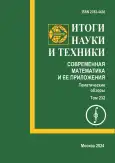Том 232 (2024)
Статьи
Применение проекционно-сеточного метода для решения нестационарной задачи
Аннотация
Работа посвящена построению приближенного решения параболического дифференциального уравнения c оператором Бесселя. Решение задачи ищется в виде линейной комбинации кусочно непрерывных базисных функций, имеющих компактный носитель. Построение решения осуществляется в два этапа. Первоначально проводится аппроксимация по пространственной переменной с использованием проекционно-сеточного метода Бубнова—Галеркина. Затем конечно-разностным методом проводится приближение по t. Возникающая при этом система уравнений имеет трехдиагональную матрицу и решается методом прогонки.
 3-12
3-12


О задачах граничного управления и оптимального управления распределенной неоднородной колебательной системой с заданными промежуточными условиями на функции состояния
Аннотация
В работе исследуется распределенная неоднородная колебательная система, у которой заданы различные состояния в промежуточные моменты времени. Рассматриваются задачи граничного управления и оптимального граничного управления такой системой. Динамика указанного объекта моделируется одномерным волновым уравнением с кусочно постоянными характеристиками, при этом колебания распространяются в однородных участках за одинаковое время. Критерий качества для задач оптимального граничного управления задан на всем интервале времени. Предложен конструктивный подход построения функции граничного управления и оптимального управления одномерными колебательными неоднородными процессами. Подход исследования базируется на методах разделения переменных, теории управления и оптимального управления конечномерными системами с многоточечными промежуточными условиями. Под действием построенного закона управления волновые колебания из заданного начального состояния переходят в заданное конечное состояние через многоточечные промежуточные состояния.
 13-29
13-29


Модели охлаждения и замораживания живой биологической ткани плоским линейчатым аппликатором
Аннотация
В работе построены новые математические модели охлаждения и замораживания живой биологической ткани плоским, достаточно протяженным линейчатым аппликатором, располагаемым на ее поверхности. Модели представляют собой двумерные краевые задачи (в том числе типа Стефана) и имеют приложение в криохирургии. Метод численного исследования поставленных задач, основан на сглаживании разрывных функций и применении к <<сглаженным>> задачам локально-одномерных разностных схем без явного выделения границы влияния холода и границ фазового перехода.
 30-36
30-36


Классическое решение третьей смешанной задачи для телеграфного уравнения с нелинейным потенциалом
Аннотация
Для телеграфного уравнения с нелинейным потенциалом, заданного в первом квадранте, рассматривается смешанная задача, в которой на пространственной полуоси задаются условия Коши, а на временной полуоси — условие третьего рода (условие Робина). Решение строится методом характеристик в неявном аналитическом виде как решение некоторых интегральных уравнений. Проводится исследование разрешимости этих уравнений, а также зависимости от начальных данных и гладкости их решений. Для рассматриваемой задачи доказывается единственность решения и устанавливаются условия, при выполнении которых существует её классическое решение. При невыполнении условий согласования строится задача с условиями сопряжения, а при недостаточно гладких данных — слабое решение.
 37-49
37-49


Обобщенные формулы Римана решения первой смешанной задачи для общего телеграфного уравнения с переменными коэффициентами в первой четверти плоскости
Аннотация
Известным методом Римана и новым методом компенсации граничного режима правой частью уравнения получены формулы Римана единственного и устойчивого классического решения первой смешанной задачи для линейного общего неоднородного телеграфного уравнения с переменными коэффициентами в первой четверти плоскости. Из постановки смешанной задачи, определения классических решений и установленного критерия гладкости правой части уравнения выведен её критерий корректности по Адамару. Этот критерий корректности состоит из требований гладкости и трёх условий согласования правой части уравнения, граничного и начальных данных. Подтверждена справедливость полученных формул Римана и критерия корректности тем, что доказано их совпадение с известными формулами классического решения и критерием корректности для модельного телеграфного уравнения.
 50-69
50-69


О преобразовании, двойственном к преобразованию Радона—Киприянова
Аннотация
Преобразование Радона– Киприянова введено в 1998 г. В теоретических и прикладных исследованиях требуется ввести двойственное (сопряженное) к нему преобразование . Доказаны теоремы об ограниченности двойственного преобразования в соответствующем подпространстве Л. Шварца основных функций и -преобразовании свертки функции с -преобразованием при условии, что обе функции и принадлежат соответствующим пространствам основных функций.
 70-77
70-77


Общая схема построения определяющей функции в задаче управления для динамической системы в частных производных разного порядка
Аннотация
Для системы управления в частных производных выведен критерий полной управляемости системы. Исследование ведется методом каскадной декомпозиции, которая заключается в пошаговом эквивалентном переходе от исходной системы к редуцированнным системам в подпространствах. Получена функция, принадлежащая подпространству минимальной размерности, определяющая вид решения задачи программного управления — функций состояния и управления в аналитическом виде. Установлены необходимые и достаточные условия существования определяющей функции, приведена схема ее построения. Найдены необходимые и достаточные условия существования определяющей функции в полиномиальном, экспоненциальном, дробно-рациональном видах; приведены формулы для построения функций такого вида. Для исходной системы построено решение задачи программного управления.
 78-88
78-88


Задачи типа Римана—Гильберта для обобщенного уравнения Коши—Римана с младшим коэффициентом, имеющим особенность в окружности
Аннотация
Целью работы является построение общего решения обобщенного уравнения Коши—Римана, коэффициент которого допускает особенность первого порядка на окружности, содержащейся в области, и исследование краевой задачи, объединяющей элементы задач Римана—Гильберта и линейного сопряжения.
 89-98
89-98


Обобщённое решение начально-граничной задачи для волнового уравнения со смешанной производной и потенциалом общего вида
Аннотация
Исследуется начально-граничная задача в полуполосе для неоднородного гиперболического уравнения второго порядка с постоянными коэффициентами, содержащего смешанную производную, с ненулевым потенциалом. Рассматриваемое уравнение является уравнением поперечных колебаний движущейся конечной струны. Рассматриваются общие начальные условия (ненулевой профиль струны и ненулевая начальная скорость точек струны) и закрепленные концы (условия Дирихле). Сформулированы теоремы о существовании и единственности решения и получены формулы для решения.
 99-121
99-121


О математических моделях вирусологии, использованных для изучения пандемии Covid-19
Аннотация
Представлен обзор отечественных и зарубежных работ, посвященных построению и исследованию математических моделей вирусологии, использованных при изучении пандемии новой коронавирусной инфекции COVID-19.
 122-139
122-139


Метод глубокого обучения для выявления аномалий в функционировании компьютерных систем
Аннотация
Задача обнаружения аномального поведения крупных программных систем может быть сведена к задаче обнаружения аномалий в потоках текстовых данных. В работе предлагается подход, основанный на комбинации глубокого обучения (автокодировщика с использованием сверточных нейронных сетей и однослойного полносвязного декодировщика) и подходов, основанных на нечетком методе кластеризации. Предложенное решение позволяет эффективно строить векторные представления групп последовательных событий и определять выбросы в данных за счет разработанного слоя, основанного на методах нечеткой кластеризации и радиально-базисных функций.
 140-152
140-152


Групповой анализ системы McKean
Аннотация
В работе исследуется кинетическая система уравнений McKean двух групп частиц. Система представляет собой кинетическое уравнение Больцмана, и для этой модели импульс и энергия не сохраняются. При помощи методов группового анализа получено решение, представляющее плотность частиц газа. Аналогичным образом можно найти точные решения для других кинетических моделей.
 153-157
153-157







